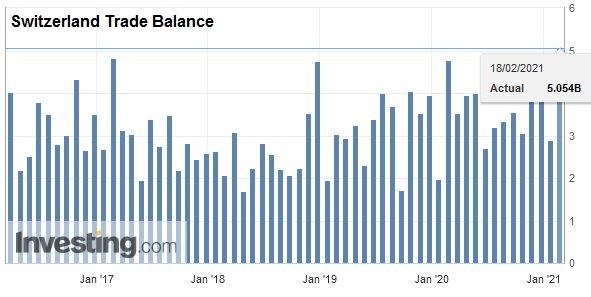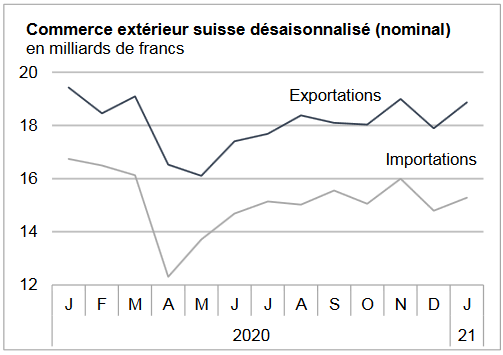We do not like Purchasing Power or Real Effective Exchange Rate (REER) as measurement for currencies. For us, the trade balance decides if a currency is overvalued. Only the trade balance can express productivity gains, while the REER assumes constant productivity in comparison to trade partners. Who has read Michael Pettis, knows that a rising trade surplus may also be caused by a higher savings rate while the trade partners decided to spend more. This is partially true. Recently Europeans started to increase their savings rate, while Americans reduced it. This has led to a rising trade and current surplus for the Europeans. But also to a massive Swiss trade surplus with the United States, that lifted Switzerland on the U.S. currency manipulation watch list. To
Topics:
George Dorgan considers the following as important: 2.) Trade Balance News Service Bunt [FR], 2) Swiss and European Macro, Featured, newsletter
This could be interesting, too:
Nachrichten Ticker - www.finanzen.ch writes Die Performance der Kryptowährungen in KW 9: Das hat sich bei Bitcoin, Ether & Co. getan
Nachrichten Ticker - www.finanzen.ch writes Wer verbirgt sich hinter der Ethereum-Technologie?
Martin Hartmann writes Eine Analyse nach den Lehren von Milton Friedman
Marc Chandler writes March 2025 Monthly
We do not like Purchasing Power or Real Effective Exchange Rate (REER) as measurement for currencies. For us, the trade balance decides if a currency is overvalued. Only the trade balance can express productivity gains, while the REER assumes constant productivity in comparison to trade partners.
Who has read Michael Pettis, knows that a rising trade surplus may also be caused by a higher savings rate while the trade partners decided to spend more. This is partially true. Recently Europeans started to increase their savings rate, while Americans reduced it. This has led to a rising trade and current surplus for the Europeans. But also to a massive Swiss trade surplus with the United States, that lifted Switzerland on the U.S. currency manipulation watch list.
To control the trade balance against this “savings effect”, economists may look at imports. When imports are rising at the same pace as GDP or consumption, then there is no such “savings effect”.
After the record trade surpluses, the Swiss economy may have turned around: consumption and imports are finally rising more than in 2015 and early 2016. In March the trade surplus got bigger again, still shy of the records in 2016.
Swiss National Bank wants to keep non-profitable sectors alive
Swiss exports are moving more and more toward higher value sectors: away from watches, jewelry and manufacturing towards chemicals and pharmaceuticals. With currency interventions, the SNB is trying to keep sectors alive, that would not survive without interventions.
At the same time, importers keep the currency gains of imported goods and return little to the consumer. This tendency is accentuated by the SNB, that makes the franc weaker.
Texts and Charts from the Swiss customs data release (translated from French).
|
Bern, 04.03.2021 – The 2020 statistics of the Federal Customs Administration (AFD) are strongly influenced by the COVID-19 pandemic. In order to reduce the risk of transmission of the coronavirus, Switzerland has reintroduced systematic checks at national borders for the first time since joining Schengen, imposed entry restrictions and temporarily closed small border posts. The rise of e-commerce has led to a significant increase in the number of counterfeit branded items in safekeeping. On the other hand, the falsified documents discovered were less numerous and the receipts declined slightly.
|
Switzerland Trade Balance, February 2021(see more posts on Switzerland Trade Balance, ) Source: investing.com - Click to enlarge |
The number of counterfeit branded articles secured in the trade of commercial goods has increased significantly: with 4,433 cases, this represents an increase of more than 50% compared to the previous year (2019: 2,906). The goods discovered are mainly watches, jewelry, eyeglasses, bags and purses. The reasons for this increase are not only the increased attractiveness of online commerce linked to COVID-19 – stores closed and shopping tourism prohibited -, but also the increase in AFD’s control activity in traffic. postal.
Due to the increase in e-commerce as well as smaller and consequently more frequent orders from businesses, customs declarations have increased significantly to reach 50 million (2019: 40 million).
In the field of narcotics, the quantities of heroin (2020: 55 kg / 2019: 20 kg) and cocaine seized (2020: 162 kg / 2019: 124 kg) have also increased. During a check at the Thayngen (SH) border post in April alone, AFD staff found 30 kilos of cocaine. The drugs had been imported into Switzerland in the loading compartment of a truck. In general, discoveries in the area of smuggling and crime remained at the same level as the previous year.
The decrease in the number of forged documents is probably due primarily to extraordinary entry restrictions. The number of falsified passports secured fell to 142, about half of the number in the previous year (2019: 292). The number of drugs and doping products discovered also decreased, with 7,486 shipments seized (2019: 9,012).
Revenue of 22 billion francs
Compared to the previous year, AFD’s overall revenues decreased slightly in 2020, from 23.0 billion francs to 21.8 billion francs. Most of the decrease is due to declining value-added tax receipts, as fewer goods were imported in that particular year. AFD’s revenue comes mainly from the value added tax, the tax on mineral oils, the tobacco tax, the levy on heavy goods vehicle traffic and customs duties at the import. With some 10 billion francs, value added tax represents almost half of AFD’s revenue in 2020, as in the previous year.
Exceptional border arrangements
On March 16, 2020, the Federal Council declared the “extraordinary situation” in accordance with the law on epidemics. As a result, systematic controls at national borders were introduced, 130 border crossings were closed and border traffic was channeled to larger border posts. In order for people working in the healthcare sector or in comparable systemically important professions to cross the border quickly, “green lanes” with dedicated lanes were put in place for the first time. To ensure the resistance capacity under the amended border arrangements, the army supported AFD with 50 military police and a total of 1,800 militia members. Their commitment has served in particular in the field of canalization measures and the green border. Various cantons have also temporarily seconded police officers to strengthen border controls. At times, cross-border human trafficking has decreased by up to 80% throughout Switzerland. After Switzerland lifted systematic national border controls on June 15, 2020, traffic again increased rapidly.
COVID-19: accelerating transformation
The pandemic has also accelerated the ongoing transformation of AFD into the Federal Office of Customs and Border Security (OFDF). The new organizational structure, with six new leadership areas and harmonized structures at regional and local levels, has already proven itself for the first time in the management of the pandemic by significantly increasing operational flexibility. Newly developed digital applications, such as connecting Switzerland to the Europe-wide Compatible Electronic Toll Service (SET), have also helped to further reduce physical contact and border crossing times.
At the end of the autumn, the recruitment campaign for the new professional profile of customs and border security specialist was successfully launched, taking a new step towards OFDF. This training will enable future AFD employees to carry out checks on goods, people and means of transport. The new training will begin in August 2021.
Tags: Featured,newsletter







